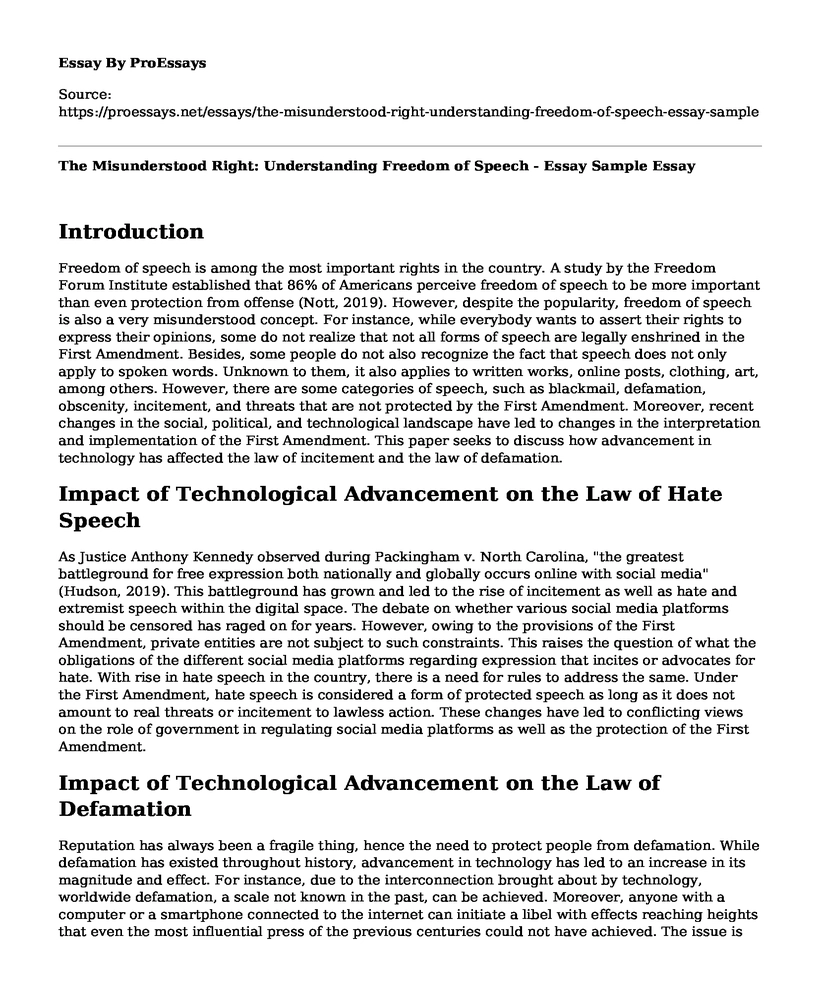Introduction
Freedom of speech is among the most important rights in the country. A study by the Freedom Forum Institute established that 86% of Americans perceive freedom of speech to be more important than even protection from offense (Nott, 2019). However, despite the popularity, freedom of speech is also a very misunderstood concept. For instance, while everybody wants to assert their rights to express their opinions, some do not realize that not all forms of speech are legally enshrined in the First Amendment. Besides, some people do not also recognize the fact that speech does not only apply to spoken words. Unknown to them, it also applies to written works, online posts, clothing, art, among others. However, there are some categories of speech, such as blackmail, defamation, obscenity, incitement, and threats that are not protected by the First Amendment. Moreover, recent changes in the social, political, and technological landscape have led to changes in the interpretation and implementation of the First Amendment. This paper seeks to discuss how advancement in technology has affected the law of incitement and the law of defamation.
Impact of Technological Advancement on the Law of Hate Speech
As Justice Anthony Kennedy observed during Packingham v. North Carolina, "the greatest battleground for free expression both nationally and globally occurs online with social media" (Hudson, 2019). This battleground has grown and led to the rise of incitement as well as hate and extremist speech within the digital space. The debate on whether various social media platforms should be censored has raged on for years. However, owing to the provisions of the First Amendment, private entities are not subject to such constraints. This raises the question of what the obligations of the different social media platforms regarding expression that incites or advocates for hate. With rise in hate speech in the country, there is a need for rules to address the same. Under the First Amendment, hate speech is considered a form of protected speech as long as it does not amount to real threats or incitement to lawless action. These changes have led to conflicting views on the role of government in regulating social media platforms as well as the protection of the First Amendment.
Impact of Technological Advancement on the Law of Defamation
Reputation has always been a fragile thing, hence the need to protect people from defamation. While defamation has existed throughout history, advancement in technology has led to an increase in its magnitude and effect. For instance, due to the interconnection brought about by technology, worldwide defamation, a scale not known in the past, can be achieved. Moreover, anyone with a computer or a smartphone connected to the internet can initiate a libel with effects reaching heights that even the most influential press of the previous centuries could not have achieved. The issue is aggravated by the fact that the existing libel rules were formulated in the age of the printing press and the telegraph, hence are unresponsive.
Moreover, technology has been changing faster than laws. Also, web crosses state as well as international boundaries hence posing another challenge. Resultantly, legislators, as well as courts, have struggled to come to terms with the effects of advancement in technology, especially social media and the internet, on defamation. For instance, there has been a rise in litigation between ordinary people over social media posts. It has been argued that the existing rules should be recast to reflect the modern changes. In response to these changes, Section 230 was passed in 1996 (Harvard Law Review, 2018). However, it has been argued that more laws need to be made to address defamation in this age.
Conclusion
The 21st century has witnessed drastic social, political, and technological advancements. While these changes have several benefits, they can also be harmful. For instance, the rise in the use of technology has led to an increase in cases of defamation and hate speech in the country. Though the First Amendment protects the freedom of expression, the landscape was different when the laws were made. With modern changes, calls have been made to recast the law. For instance, laws should be enacted to address the rise in litigation for defamation among private entities.
References
Harvard Law Review. (2018, May 10). Section 230 as First Amendment Rule. Retrieved December 9, 2019, from Harvard Law Review: https://harvardlawreview.org/2018/05/section-230-as-first-amendment-rule/
Hudson, D. L. (2019, April 1). Free speech or censorship? Social media litigation is a hot legal battleground. Retrieved from ABA Journal: http://www.abajournal.com/magazine/article/social-clashes-digital-free-speech
Nott, L. (2019). Is your Speech Protected by the First Amendment? Retrieved from Freedom Forum Institute: https://www.freedomforuminstitute.org/first-amendment-center/primers/basics/
Cite this page
The Misunderstood Right: Understanding Freedom of Speech - Essay Sample. (2023, Mar 14). Retrieved from https://proessays.net/essays/the-misunderstood-right-understanding-freedom-of-speech-essay-sample
If you are the original author of this essay and no longer wish to have it published on the ProEssays website, please click below to request its removal:
- Essay on Racial Stereotype against Hispanic/Latinos in the U.S
- Seneca Falls: Women's Rights Convention Essay
- Martin Luther's Influence on Physical Education - Research Paper
- Essay Example on FARC: Revolution, Inequality & Violations of Human Rights
- Essay Sample on Navigating Gay Rights: The Dilemmas & Challenges Facing the State
- Paper Sample on Cultural Theory: Explaining Jewish vs Italian Immigrants in America 1910-1914
- Free Paper on Tobacco Abuse: A Growing Global Threat to Human Health







